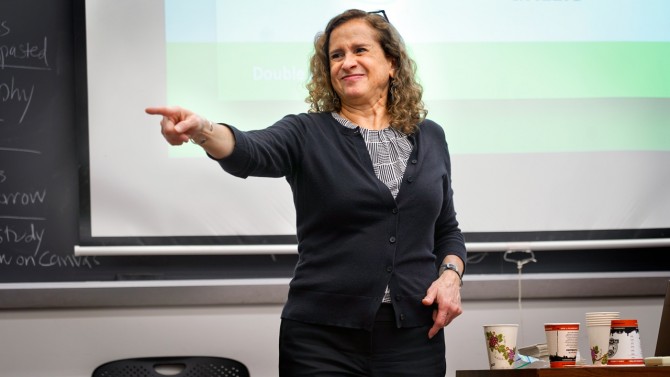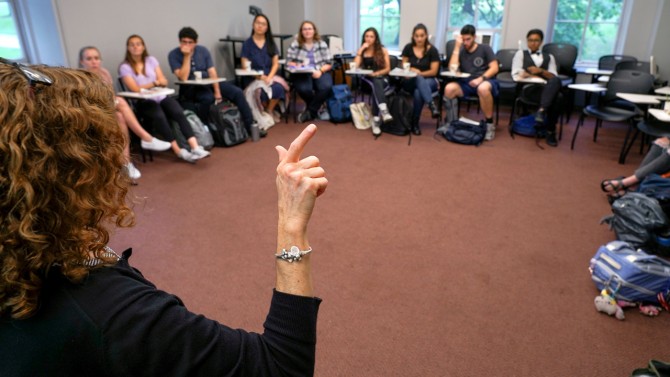Senior lecturer Brenda Schertz teaches the first American Sign Language classes at Cornell that meet the College of Arts and Sciences’ three-semester world language requirement.
Sign of the times: American Sign Language thrives on campus
By Susan Kelley
The voices of 15 students are silent on a recent morning in a language classroom in Morrill Hall. But their faces, bodies and hands are communicating loud and clear.
They tilt their heads, morph their mouths and hands into precise shapes, raise and lower their eyebrows, and shift their expressions as they direct their classmates to place a pencil in a cardboard box or turn a paper cup upside down and place it on a table.
Using their bodies, they are communicating in American Sign Language (ASL). For the first time, ASL is being offered at Cornell during the regular academic year and meets the College of Arts and Sciences’ three-semester world language requirement, thanks to a grassroots, student-led campaign.
In this lesson, the students are learning that certain handshapes describe a category of objects. For example, when passing a cup, students use the “C” handshape. To describe placement of a flat object, they use the “B” handshape. An index finger describes skinny objects.
Like most language classes, ASL 1101 is full immersion: Speaking is not allowed.
“It makes your brain click to ASL,” says Sara DeGraw ’23, who plans to use ASL to train animals as a veterinarian. “When I’m in here, my brain thinks differently than outside.”
At the chalkboard is senior lecturer Brenda Schertz, a whirlwind of energy who has been teaching ASL for more than 20 years at institutions including Northeastern University, Emerson College, the University of Southern Maine and the National Technical Institute for the Deaf at the Rochester Institute of Technology.
“I actually started teaching ASL in fifth grade,” says Schertz, a native speaker of ASL who is deaf. “I went to a public school, and my classmates didn’t sign, so I had to teach my peers to communicate with me.”
ASL students initially think they should focus just on their hands, Schertz says. But ASL is a three-dimensional language that requires multitasking throughout the body.
“It’s kind of like learning to drive,” Schertz says. “You have to figure out where the shift stick is, where the turn signal is and turn the steering wheel all at the same time. It feels awkward at first, but with practice it becomes second nature.”
Schertz keeps her class moving with lots of interactive activities, including card games such as Go Fish, and quick dialogue exercises. That creates a generous, open environment in which students collaborate to figure out how to sign with each other.
“She has a very unique way of keeping the class immersed,” said Corinne Cioffi ’21, a linguistics major who plans to use ASL in a career in speech pathology or speech therapy. “I’ve taken Italian and Spanish, and [this class is] unlike anything I’ve ever experienced. I’ve never felt so connected with everybody.”
ASL came to Cornell thanks in large part to the student-run Cornell University Deaf Awareness Project. Its lobbying efforts prompted A&S faculty to change in 2018 their definition of “language” to include signed languages, allowing ASL to fulfill the foreign language requirement. According to the Modern Language Association, ASL is the third-most commonly taught language at colleges and universities (other than English), after Spanish and French. At Cornell, ASL is offered through the Department of Linguistics in A&S.
Students in ASL 1101 learn basic grammar and vocabulary, including the fundamental parts of a sign and proper use of fingerspelling. In the spring semester, Schertz will teach ASL 1102; it will offer a deeper exploration of ASL grammar, vocabulary and culture, as well as social issues in the deaf community. Two subsequent levels will round out the four-course ASL sequence. Schertz expects that with two years of instruction, students will be fluent in ASL.
In addition to teaching, Schertz has become a campus resource. She’ll collaborate with Cheng Zhang, assistant professor of information science, who is doing research on wearable technology involving finger movements. She’s working with Cornell Cinema to choose a deaf film for an upcoming screening, and will give a guest presentation on a deaf film character next semester in an Eastern European film class. And she’s consulted with Performing and Media Arts faculty on upcoming events involving Peter Novak, who directed an ASL translation of “Twelfth Night.”
“Deaf film, theater and art are powerful avenues for the expression of deaf culture, values and beliefs,” Schertz says, “and these are excellent ways to make more visible a culture that has been invisible far too long.”
Dana Meskan ’21, a junior linguistics major and the secretary of the Deaf Awareness Project, appreciates Schertz’s expertise as a native speaker of ASL. “Like any language,” she says, “you get more out of it when you learn it from someone who grew up in that culture.”
So that students will be comfortable speaking with people who are deaf, Schertz assigns class readings and discussions that acquaint students with American deaf history, education and cultural norms.
For example, Meskan learned that in the deaf community, walking in between two people who are signing to each other is perfectly acceptable. “In hearing culture, you would never do that,” Meskan says.
Schertz hopes her students will also learn that ASL is a language not just for deaf people – and that deaf people should be seen as a cultural and language minority. “While it is true that most people would see deaf people as people with a disability, their perspective will quickly change after learning the richness of the language and deaf culture,” Schertz says.
“And talking to other people is just fun,” she adds. “That’s what’s important.”
Cioffi agrees. Prior to taking Schertz’s class, her only exposure to ASL was in high school, where one of her volleyball teammates was deaf.
“It was very hard for us to communicate,” Cioffi says. “She taught us some basic signs, like ‘hello,’ ‘thank you’ and ‘please,’ but nothing like I’m learning now. I really hope I can take back home everything I learn from this class and be able to have a conversation with her that I’ve never been able to have before.”
Media Contact
Get Cornell news delivered right to your inbox.
Subscribe


